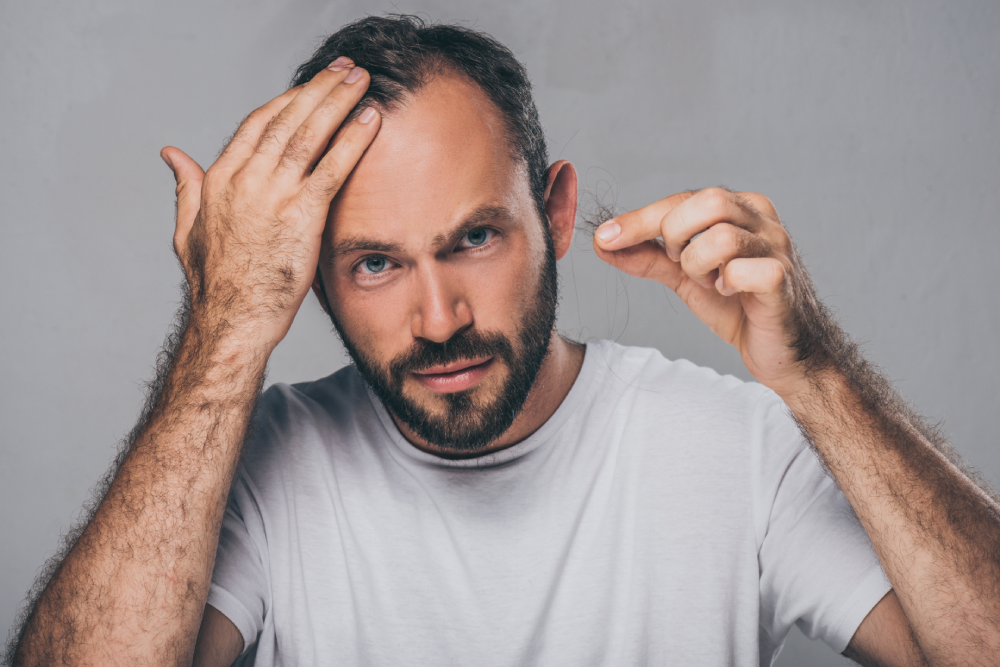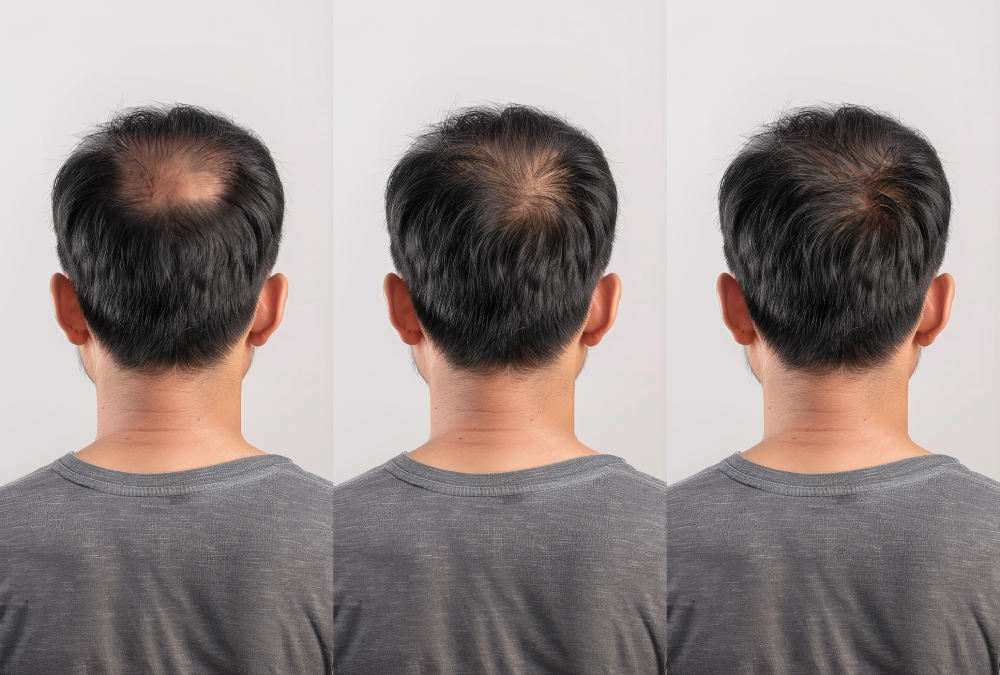Ever noticed more hair in your brush during certain times of the year? You’re not alone. Seasonal hair loss is a real phenomenon, and understanding it is the first step toward managing it. Enter PRP hair restoration—a natural, non-surgical treatment that uses your body’s own growth factors to rejuvenate your hair.
Let’s delve into the causes of seasonal hair loss and how PRP therapy can be your ally in maintaining luscious locks year-round.
Hair growth occurs in cycles: anagen (growth), catagen (transition), telogen (resting), and exogen (shedding). Disruptions in this cycle can lead to noticeable hair loss.
Factors Contributing to Hair Loss
Several factors can lead to hair loss:
- Hormonal Changes: Fluctuations during pregnancy, menopause, or thyroid issues can affect hair growth.
- Nutritional Deficiencies: Lack of essential nutrients like iron, vitamin D, and protein can weaken hair.
- Stress: Physical or emotional stress can push hair into the telogen phase, leading to shedding.
- Medications: Certain drugs, including chemotherapy agents and antidepressants, may cause hair loss.
- Hairstyling Practices: Excessive heat, tight hairstyles, and harsh chemicals can damage hair follicles.
At Introspect Wellness, we offer PRP hair restoration to address these concerns by stimulating natural hair regrowth.
Demystifying PRP Hair Restoration
Platelet-rich plasma (PRP) therapy involves drawing a small amount of your blood, processing it to concentrate the platelets, and injecting it into the scalp. These platelets release growth factors that stimulate hair follicles, promoting hair growth and improving hair density. It’s a natural, minimally invasive procedure with little to no downtime.
Seasonal Hair Loss: Fact or Fiction?
Yes, seasonal hair loss is real. Studies have shown that hair shedding peaks during late summer and early autumn. This pattern is believed to be linked to the hair growth cycle, where more hairs enter the telogen (resting) phase during these seasons, leading to increased shedding.
Environmental factors like reduced sunlight and changes in humidity can also impact hair health.

Strategies to Combat Hair Loss
Let’s face it—watching your hair shed like leaves in autumn can be stressful (and, honestly, a little dramatic). But before you start frantically Googling wigs or blaming your shampoo, let’s talk about the proactive steps you can take to reduce shedding and get your hair groove back.
The good news? You have more control than you think. From daily rituals to science-backed treatments, here’s how to fight back against seasonal (and non-seasonal) hair loss in a way that’s smart, sustainable, and totally doable.
1. Eat Like Your Hair’s Watching
Your strands are made of protein. If your meals are more “cup noodles and vibes” than well-balanced nutrition, your hair is going to feel it. Hair follicles are greedy—they thrive on a constant supply of vitamins, minerals, and proteins to do their thing.
Make sure you’re getting enough:
- Iron (for healthy circulation)
- Biotin (for strength)
- Zinc (for repair)
- Vitamin D (for follicle stimulation)
- Omega-3 fatty acids (for shine and scalp hydration)
Pro tip: Add salmon, spinach, eggs, nuts, and sweet potatoes into your weekly rotation. Your hair (and skin and nails) will thank you.
2. Stop Playing Tug-of-War with Your Scalp
We’ve all done it—tight ponytails, aggressive brushing, flat ironing like there’s no tomorrow. But all that styling stress adds up. Think of your hair follicles as tiny plants. They won’t grow well if you yank on them, fry them, or starve them.
Here’s what you can do:
- Use heat tools on low settings, and always apply a heat protectant.
- Opt for silk pillowcases to reduce friction while you sleep.
- Skip hairstyles that pull tight at the root (buns that give you a facelift? Yeah, no).
- Use a wide-toothed comb instead of a brush on wet hair.
Gentler habits = stronger, happier hair.
3. Keep Stress From Sabotaging Your Hairline
Did you know that stress can literally push your hair into the shedding phase? It’s called telogen effluvium, and it’s real. Major life events, emotional upheaval, or even your jam-packed calendar can disrupt your hair growth cycle and lead to noticeable hair fall.
You can’t avoid stress entirely, but you can manage how you react to it. Try:
- Daily movement, even a 15-minute walk
- Meditation apps (Headspace, Calm, Insight Timer—yes, we’ve tried them all)
- Breathwork or yoga, especially during high-pressure weeks
- Laughing with friends—science says it lowers cortisol levels
The takeaway? De-stressing is more than self-care—it’s part of your haircare.
4. Massage Like You Mean It
A scalp massage isn’t just relaxing—it’s surprisingly powerful. Massaging the scalp stimulates blood circulation, which helps deliver oxygen and nutrients to your hair follicles. It can also reduce tension (which we already know contributes to hair loss).
The best part? You don’t need fancy tools (although a silicone scalp brush is divine). Just use your fingertips in small circular motions for five minutes a day—while shampooing or even while watching TV. Bonus points if you use a nourishing oil like rosemary, castor, or argan oil to add strength and shine.
Massage = mood boost + hair growth. A win-win.
5. Get Professional With It
If your hair loss is sudden, patchy, or just not improving no matter what you try, it’s time to bring in the pros. A board-certified provider or trichologist can run labs, assess your scalp health, and rule out underlying issues like:
- Thyroid disorders
- Hormonal imbalances
- Autoimmune conditions
- Vitamin or iron deficiencies
This isn’t about guessing—it’s about getting the real answers. Once you know what’s going on internally, you can build a hair loss treatment plan that actually works. And yes, one of those options might be a game-changing regenerative treatment like PRP.
Which brings us to…
6. Give PRP Hair Restoration a Try
Think of PRP therapy for hair as a green juice cleanse—but for your scalp. It uses your body’s own platelets (from a small blood draw), spins them down to concentrate the growth factors, and then injects them back into areas of hair thinning or shedding. It’s like turning on your follicles’ motivational speaker.
Here’s why it’s gaining so much buzz:
- It’s natural, using your own biology.
- It’s non-surgical, no scalpels or incisions here.
- It’s minimally invasive, with little to no downtime.
- It’s effective for both men and women experiencing pattern hair loss, postpartum thinning, or stress-related shedding.
At Introspect Wellness, PRP isn’t just a buzzword—it’s an advanced, thoughtful hair regrowth treatment backed by real science. Over time (typically after a series of treatments), many clients notice fuller, thicker hair that feels like it’s finally fighting back.
So whether your hair is “seasonally dramatic” or just hasn’t been the same since that breakup in 2019, PRP therapy for hair might be the missing piece in your thinning hair solution.

Embrace Fuller Hair with PRP Hair Restoration
Seasonal hair loss doesn’t have to be a permanent concern. With the right approach and treatments like PRP therapy, you can maintain healthy, vibrant hair throughout the year.
At Introspect Wellness, Keene, NH, we’re committed to helping you achieve your hair restoration goals with personalized care and advanced treatments. Call us now to schedule your appointment!

